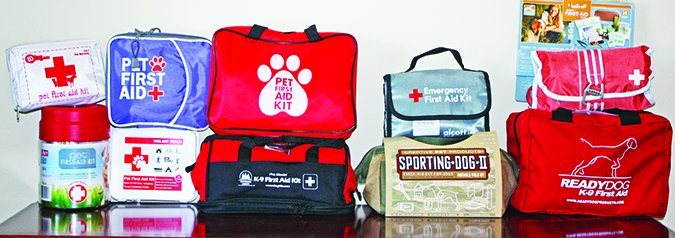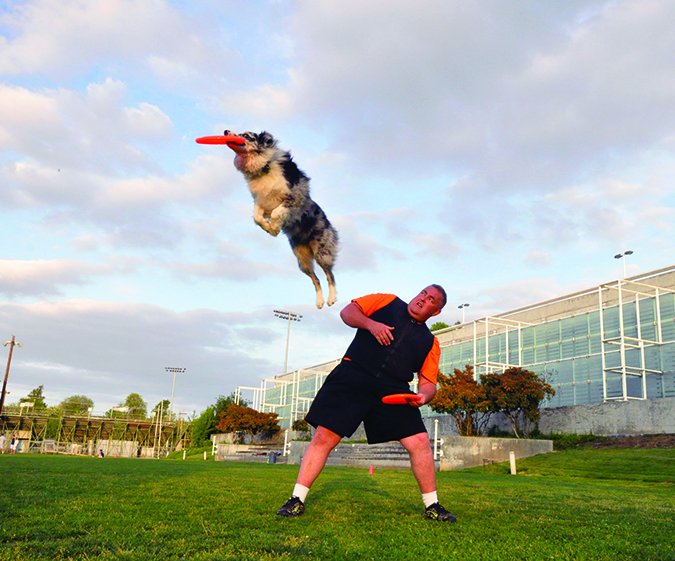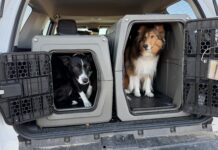Now that the warmer weather is on its way, many of us will be thinking of the different places and things we can do with our dogs in the great outdoors.
But before you embark on a trip with your dog, think of her individual preferences in addition to yours. It’s wonderful when your dog is easygoing and gets along with everyone. Our dog Helen of Troy, CGC, TT, ATD, is one of those – she greets all humans and other dogs (and even cats and rabbits!) with a happy tail wag and sniff. But your dog may not be as social, so determine realistically the sort of places and times where and when your dog will be most comfortable. Is there a particular path or trail that is less populated at certain times? If your dog is reactive, maybe it’s time to work on some counter-conditioning and desensitization before embarking. (See “Leash Reactivity in Otherwise Friendly Dogs,” May 2012.)

You could also enroll in a “Reactive Rover” class in your area as a prerequisite to your outdoor experience (but first make sure the trainer uses positive-reinforcement methods!). If there aren’t any such classes accessible to you, check out the following resources:
“The Leash Reactivity Blueprint,” (DVD), by Tristan Flynn
“Reactivity: A Program for Rehabilitation,” (DVD), by Emily Larlham
Beware of the Dog, by Pat Miller
Even if your dog is not reactive, get him ready for the great outdoors by practicing some basic manners, such as checking in with you (see “Train Your Dog to ‘Check In’,” March 2017); playing the “name game” (see “The Importance of a Dog’s Name with Regard to Training,” January 2011); reliable recalls (see “Rocket Recall,” September 2015); and loose-leash walking (“Loose Leash Walking: Training Your Dog Not to Pull,” April 2017). You can practice all of this in the comfort of your own home and, if available, your own backyard before venturing far afield. Or if possible, take a brush-up Good Manners class with a trainer who uses positive-reinforcement-based training.
Part of your spring planning might be to evaluate the equipment you currently use to walk your dog. If it’s working for you, great. If your dog is pulling hard, apart from working on your technique, perhaps look into a front clip harness (“The 2017 Best Dog Harnesses Review,” April 2017), combined with a martingale collar or a head halter. (See this Jean Donaldson video on conditioning your dog to enjoy wearing a head halter.)
Always Check Dog Policies to Avoid Disappointment
In preparing for your outing, make sure you check the rules. In our area, many of the trails and parks permit dogs but they must be leashed. I have, however, encountered locations that don’t allow dogs at all. Don’t risk receiving a citation after you’ve spent time and resources to get there; be sure you know you will be welcome with your canine companion.
I always remind my Family Manners clients that everyone is not required to love your dog. So, don’t allow your dog to greet strangers – human or otherwise – without an invitation. As for greeting other dogs on leash – it’s not the best scenario for a happy outcome. Similarly, if your dog is not comfortable meeting new people, just politely and firmly say to all would-be greeters, “My dog is not friendly” and move on.
Of course, you will always be ready to pick up your dog’s waste. If people see owners who allow their dogs to defecate without cleaning up, run amok, and make themselves a nuisance, the areas where dogs are permitted will shrink.
Depending on the jurisdiction, you may need to carry proof of your dog’s rabies vaccination and licensing. In some areas it’s not enough to have a tag on your dog; you need a copy of the actual license. If you are traveling out of state with your dog, you may need a health certificate from your veterinarian.
Summer Dog Gear
Assuming your dog is physically and behaviorally ready to hit the trail, prepare yourself and your dog for your outing. It’s a great idea to carry a backpack (and there are even nice ones your dog can carry as well) to carry all your trail essentials:
– Water (I use a bottle called a Gulpy, a plastic bottle that has a nifty device that allows your dog to drink right from the bottle without an additional bowl; see New Angle Pet Products)
- Snacks for you and your dog, including training treats
- Poop bags (This goes without saying!)
Unless your dog has an absolutely rock-solid recall, I suggest keeping her on a leash. You can use a longer one on the trail if that’s helpful to you; there are nice 15-footers that will allow you to give your dog more freedom, such as the ones made by Bridgeport Equipment, or a long line. (WDJ editor Nancy Kerns is never without her favorite, soft long line from White Pine Outfitters.)
I don’t recommend using retractable leads; the thin line can do damage to your hands if you grab it, and if dropped, the plastic handle can become a flying missile that scares your dog into a panicked run.
Be sure your dog has a tag on him with your current phone number on it – and carry a cellphone in case of emergency. It’s a good idea to put together a basic first-aid kit that you keep in your car, with some essentials like gauze, bandages, sterile tape, cold compress, hydrogen peroxide, blanket, antibiotic cream, Benadryl (check with your vet regarding appropriate dosage for your dog), muzzle, and tweezers. (See our review of pet first-aid kits in the May 2015 issue.)

When hiking in the back country, I also always carry yummy treats and a can of Spray Shield (formerly Direct Stop) citronella spray. You never know when you might encounter a threatening dog and need to use the spray defensively. (See “Tips on Stopping a Loose Dog from Approaching You,” May 2016.)
While vacationing on an island a couple of summers ago, my husband, our dog Helen, and I were standing by the harbor as a family came in on their dingy. Their dog visually locked onto Helen, and I sensed trouble even before he jumped out of their boat and made a beeline for us.
My husband scooped up our 39-pound pittie and while the other dog completely ignored his owners’ shouts, I tossed treats at him, heading toward his owners while Paul and Helen got away. If the treats didn’t work, I was prepared to use the spray (but, thank goodness, I didn’t have to). The spray is citronella-based and while it does no permanent harm, it will deter many dogs that are not as easily dissuaded by treats.
You may want to invest in one of the great treat bags WDJ reviewed in the August 2016 issue, which allow you to carry these essentials right on your belt.
Of course, it’s critical that you consider your dog’s comfort and hydration during any summertime activity. Heatstroke is a very real and dangerous (but fortunately preventable) condition, and dogs who haven’t been slowly acclimated to exercising in high temperatures are at the highest risk. Make sure you have sufficient water to offer him, and offer it often! (See “Keep Your Dog Cool and Hydrated This Summer,” May 2004.)
The Premack Principle
A great thing about figuring out what makes your dog happy in terms of exercise and play time is you can use it for training. There is a behavioral principle conceived by Professor David Premack, popularly known as the “Premack Principle.” (It’s also known as Grandma’s Law: “You have to eat your vegetables before you can have your dessert.”) It states that you can use more probable behaviors to reinforce less probable ones. It means that you can get your dog to perform a less-fun behavior in order to have the opportunity to perform a more desirable behavior.
It’s a simple concept – if your dog can’t wait to get out to play with his favorite toy in the yard, ask him to sit politely at the door. Once he has achieved this, you can say, “Yes!” and throw him the toy.
Similarly, at the lake, if he is shaking with excitement to get in the water, don’t just let him drag you there. Ask him to sit, walk politely, and, if necessary, even retreat to your vehicle. Don’t let him wade or swim until he exhibits the self-control necessary to walk on a loose leash – and then let him have a blast!

Activity Ideas for Dogs
What about swimming? Many dogs absolutely love to engage in this activity, but some don’t. Don’t coerce your dog into the water; that’s not going to improve his association with swimming. Our dog Chester was tentative when we first introduced him to water, but dove in when we started throwing his beloved toys into the wet stuff.
There are many great floatable toys that your dog may enjoy retrieving, such as the Kong Company’s Wubba toy. We found that just 10 to 15 minutes of this game resulted in a happy and tired dog. I do suggest you keep your dog on a long line and even have her wear a life vest made for dogs. (See “The Best Life Jackets for Dogs,” July 2016.) Dogs drown, too! Don’t even think of letting your dog have access to a pool or other body of water without careful supervision; my cousins lost their beautiful American Staffordshire Terrier when he couldn’t get out of a neighbors’ pool, and drowned.
Once home, I advise rinsing your dog off well. Whether the dog was in a chlorinated pool or in a natural body of water, there are plenty of potential irritants that can make your dog itchy.
Many people love to run with their dogs. Count me among them (when Chester was younger)! It’s important to assess the physical condition of your dog and the potential effects of running on his joints.
Consult with your veterinarian about when it’s advisable to run a growing dog for extended periods, especially on hard surfaces. Once your dog is fully mature and you have determined he enjoys this activity, go for it! Be prepared with your treats, dog deterrent spray, and water.
Just as we are always advised to start slowly and work up to longer distances, so should we do with our dogs. In very warm weather, keep your runs short, or schedule these outings for cooler early-morning or evening hours. (For tips on starting an exercise program that will benefit you and your dog, see “Fitness Together,” April 2013.)
Don’t overlook social activities with your dog! Many towns have dog parks and some even have restaurants that offer “Yappy Hours” for people who want to bring their dogs and socialize. Many farmers’ markets allow people to bring their dogs, and parks and ballgames are other potential venues for summer fun.

Assess whether your dog is a candidate for such close quarters with other dogs and people. Be certain your dog will be an ambassador for his species and not make himself a nuisance by jumping on people or grabbing food out of children’s hands. Even if your dog is a good citizen, you may encounter other dogs who are not, and humans who are oblivious to their dogs’ behaviors.
If you have a young dog or puppy, socialization is important, but make sure it’s a positive experience for your young dog and don’t let him get overwhelmed. (See “The Complete Puppy Socialization Guide,” May 2017.)
If you’d like to try a dog park, go by yourself first, and just observe from outside the fenced area. Does it seem well managed? Are small dogs separated from large? What’s the culture like;: Are the owners attentive, or just socializing among themselves and ignoring inappropriate canine behavior? Do the dogs get along, or is bullying happening – or even actual fights breaking out? If your assessment is positive, give it a try. (See “Dog Park Etiquette,” September 2006.)
If the park looks more hazardous than happy, you may be better off setting up your own play dates, by inviting a couple of friends with nice, friendly dogs to your fenced yard, or borrowing a yard from a friend or neighbor for that purpose. In a familiar environment, you can better manage the dogs’ interactions, and keep the number appropriate. If play gets too rough, ask your dog to come, reward her, let her rest a bit, and then rejoin.
For those of us who like more organized canine activities, search out local dog clubs and training centers and try a new sport! See WDJ’s past articles:
“Canine Agility Training: The Ultimate Team Sport,” (April 2002)
“Canine Sports: Competitive Obedience,” (June 2010)
“Disc Dog Competitions,” (February 2010)
“Flyball Racing,” (May 2002)
“Lure Coursing: Is Your Dog Up for the Chase?” (September 2009)
“Canine Musical Freestyle,” (November 2004)
“Dog Parkour: Canine Urban Athletes,” (March 2017)
“Rally Obedience Classes for Dogs,” (July 2000)
“Stand-Up Paddleboarding with Your Dog,” (August 2014)
“Canine Sports: Tracking,” (July 2010)
“Treibball: A New Herding Sport – No Sheep Required,” (July 2011)
Driving With Your Dog
I always crate my dogs when they are in my vehicle. If we were in an accident, the crate would likely contain them.
I have identifying information contained within a plastic sleeve attached to their crates, complete with the phone numbers of friends in case my husband and I were too badly hurt to help our dogs. I keep a copy of my dogs’ rabies certificates and licenses there, as well as a statement about each dog and guaranteeing the payment of any vet bills.
If you prefer to use a seatbelt for your dog, check out WDJ’s top picks for car safety harnesses in the January 2015 issue.
Conclusion
There are countless other activities for your dogs outside whether, it’s in your own backyard chasing a ball, fetching a flying disc, or playing with a flirt pole (such as the one made by Squishy Face Studio and available from Chewy.com and other online outlets), or hiking, swimming, or running. See WDJ Training Editor Pat Miller’s book, Play With Your Dog, for even more ideas. Exercising your dog in this way will likely result in a calm and peaceful dog at home, but will also strengthen your relationship with your canine companion. Isn’t that what it’s all about?
Helene Goldberger, Esq., CPDT-KA, PMCT, grew up with dogs and pursued a better way to train in order to help her fear-aggressive dog, Chester Bighead, CGC, TT. This path led her to becoming a professional trainer; her training business is called HeartDog. Helene is of counsel to Tooher & Barone, LLP, an environmental law firm, in Albany, NY.





